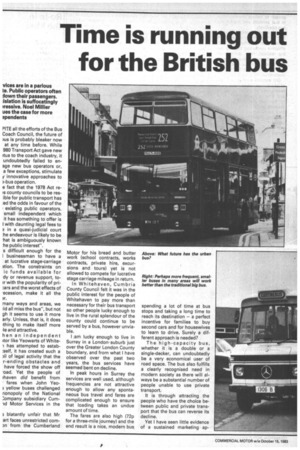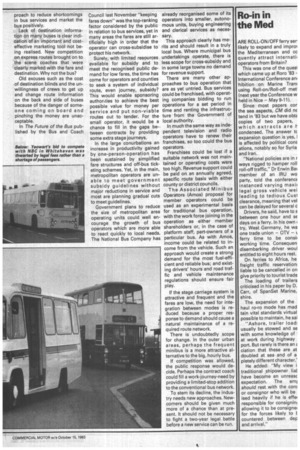Time is running out for the British bus
Page 38

Page 39

If you've noticed an error in this article please click here to report it so we can fix it.
vices are in a parlous te. Public operators often down their passengers. islation is suffocatingly lressive. Noel Millier ues the case for more F)pendents
PITE all the efforts of the Bus Coach Council, the future of )us is probably bleaker now at any time before. While 980 Transport Act gave new :tus to the coach industry, it undoubtedly failed to enage new bus operators or, a few exceptions, stimulate y innovative approaches to 3-bus operation.
e fact that the 1978 Act re!s county councils to be resible for public transport has ed the odds in favour of the existing public operators. small independent which it has something to offer is I with daunting legal fees to a in a quasi-judicial court :he endeavour is likely to be hat is ambiguously known he public interest".
s difficult enough for the I businessman to have a at lucrative stage-carriage 3tion. The constraints on ic funds available for dy or revenue support, to3r with the popularity of pri:..ars and the worst effects of .ecession, make it all the 3r.
many ways and areas, we Id all miss the bus", but not gh it seems to use it more arly. Unless, that is, it does Thing to make itself more le and attractive.
hen an independent rtor like Yeowarts of Whitehas attempted to estab:self, it has created such a )il of legal activity that the r-ending obstacles and have forced the show off pad. Yet the people of :haven did benefit from fares when John Yeo1 yellow buses challenged nonopoly of the National -.:ompany subsidiary Cum-id Motor Services in the
Motor for his bread and butter work (school contracts, works contracts, private hire, excursions and tours) yet is not allowed to compete for lucrative stage carriage mileage in return.
In Whitehaven, Cumbria County Council felt it was in the public interest for the people of Whitehaven to pay more than necessary for their bus transport so other people lucky enough to live in the rural splendour of the county could continue to be served by a bus, however unviable.
I am lucky enough to live in Surrey in a London, suburb just over the Greater London County boundary, and from what I have observed over the past two years, the bus services have seemed bent on decline.
In peak hours in Surrey the services are well used, although frequencies are not attractive enough to allow any spontaneous bus travel and fares are complicated enough to ensure that loading takes an undue amount of time.
The fares are also high (72p for a three-mile journey) and the end result is a nice, modern bus spending a lot of time at bus stops and taking a long time to reach its destination — a perfect incentive for families to buy second cars and for housewives to learn to drive. Surely a different approach is needed?
The high-capacity bus, whether it is a double or a single-decker, can undoubtedly be a very economical user of road space. The bus also fulfills a clearly recognised need in modern society as there will always be a substantial number of people unable to use private transport.
It is through attracting the people who have the choice between public and private transport that the bus can reverse its decline.
Yet I have seen little evidence of a sustained marketing ap proach to reduce shortcomings in bus services and market the bus positively.
Lack of destination informa tion on many buses is clear indication of an important and costeffective marketing tool not being realised. New competition on express routes brought on to the scene coaches that were clearly marked with the fare and destination. Why not the bus?
Old excuses such as the cost of destination blinds and the unwillingness of crews to get up and change route information on the back and side of buses because of the danger of someone coming on board and pinching the money are unacceptable.
In The Future of the Bus published by the Bus and Coach
Council last November "keeping fares down" was the top-ranking factor considered by the public in relation to bus services, yet in many areas the fares are still artificially high in order that the operator can cross-subsidise to protect his network.
Surely, with limited resources available for subsidy and to meet the recognised public demand for low fares, the time has come for operators and counties to seek a system of individual route, even journey, subsidy? This would enable sponsoring authorities to achieve the best possible value for money per service and put non-viable routes out to tender. For the small operator, it would be a chance to fill in the gaps between contracts by providing some extra stage journeys.
In the large conurbations an increase in productivity gained by one-person-operation has been sustained by simplified fare structures and off-bus ticketing schemes. Yet, in the main, metropolitan operators are unable to meet government subsidy guidelines without major reductions in service and most are planning gradual cuts to meet guidelines.
Government plans to reduce the size of metropolitan area operating units could well encourage the growth of bus operators which are more able to react quickly to local needs. The National Bus Company has already reorganised some of its operators into smaller, autonomous units, buying engineering and clerical services as necessary.
This approach clearly has merits and should result in a truly local bus. Where municipal bus undertakings operate, there is less scope for cross-subsidy and in some large towns no demand for revenue support.
There are many other approaches to bus operation that are as yet untried. Bus services could be franchised, with operating companies bidding to run operations for a set period in time and renting the infrastructure from the Government of local authority.
In much the same way as independent television and radio operators have to renew their franchises, so too could the bus operators.
Franchises could be lost if a suitable network was not maintained or operating costs were too high. Revenue support could be paid on an annually agreed, specific route basis with either county or district councils.
The Associated Minibus Operators (Amos) proposal for member operators could be used as an experimental basis for traditional bus operation, with the work force joining in the operation as either member shareholders or, in the case of platform staff, part-owners of a particular bus. As with Amos, income could be related to income from the vehicle. Such an approach would create a strong demand for the most fuel-efficient and reliable bus; and existing drivers' hours and road traffic and vehicle maintenance regulations should ensure fair play.
If the stage carriage system is attractive and frequent and the fares are low, the need for integration between modes is reduced because a proper response to demand should cause a natural maintainance of a required route network.
There is undoubtedly scope for change. In the outer urban areas, perhaps the frequent minibus is a more attractive alternative to the big, hourly bus.
If competition was allowed, the public response would decide. Perhaps the contract coach could fill a work-journey-need by providing a limited-stop addition to the conventional bus network.
To stem its decline, the industry needs new approaches. Newcomers should be given much more of a chance than at present. It should not be necessary to fight a two-year legal battle before a new service can be run.






















































































































